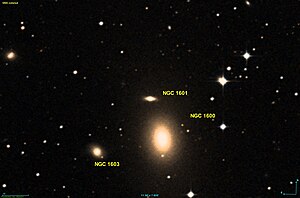NGC 1601
| Galaxy NGC 1601 |
|
|---|---|

|
|
| AladinLite | |
| Constellation | Eridanus |
|
Position equinox : J2000.0 , epoch : J2000.0 |
|
| Right ascension | 04 h 31 m 41.7 s |
| declination | -05 ° 03 ′ 37 ″ |
| Appearance | |
| Morphological type | S0: |
| Brightness (visual) | 13.8 mag |
| Brightness (B-band) | 14.8 mag |
| Angular expansion | 0.6 ′ × 0.3 ′ |
| Position angle | 90 ° |
| Surface brightness | 11.9 mag / arcmin² |
| Physical data | |
| Affiliation | NGC 1600 group |
| Redshift | 0.016668 +/- 0.000187 |
| Radial velocity | 4997 +/- 56 km / s |
|
Stroke distance v rad / H 0 |
(220 ± 16) · 10 6 ly (67.4 ± 4.8) Mpc |
| history | |
| discovery | George Stoney |
| Discovery date | January 14, 1849 |
| Catalog names | |
| NGC 1601 • PGC 15413 • MCG -01-12-018 • 2MASX J04314173-0503369 • LEDA 15413 • LDCE 312 NED012 | |
NGC 1601 is a lenticular galaxy of the Hubble type S0 in the constellation Eridanus in the southern sky . It is estimated to be 220 million light years from the Milky Way and about 40,000 light years in diameter .
The galaxies NGC 1600 , NGC 1603 , NGC 1606 , IC 373 are located in the same area of the sky .
The object was discovered by George Johnstone Stoney on January 14, 1849 .
Web links
Commons : NGC 1601 - collection of images, videos, and audio files
